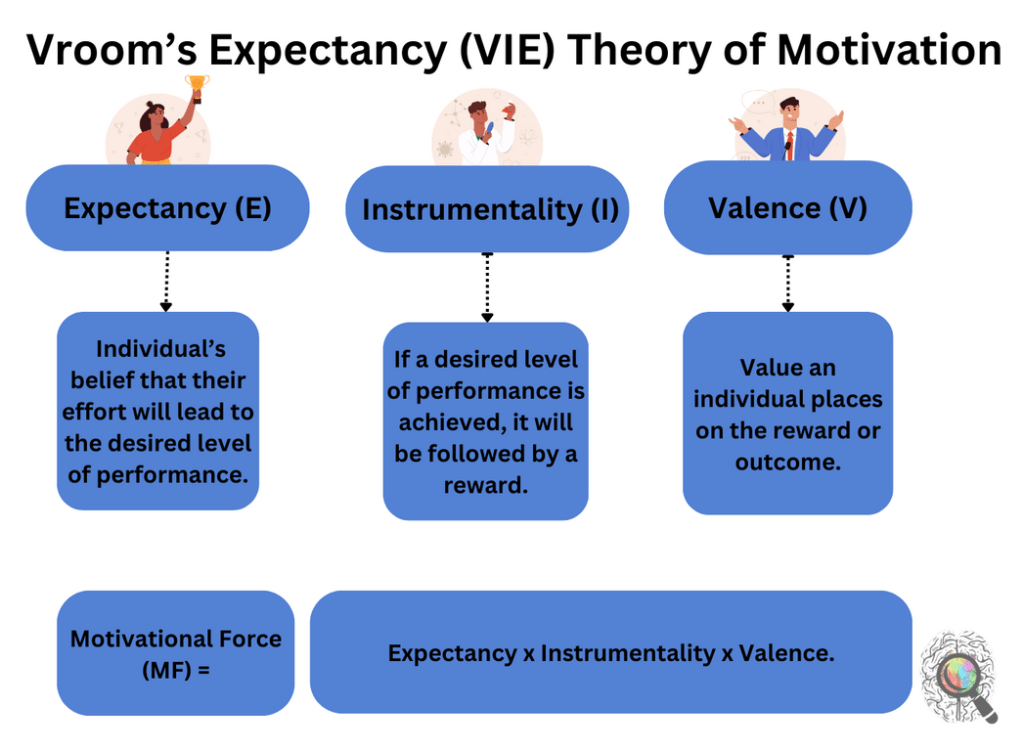Vroom’s Expectancy (VIE) Theory of Motivation, was proposed by Victor Vroom, a professor at Yale University of Management in his book “Work and Motivation” in 1964.
Also known as valence-instrumentality-expectancy theory, It is one of the prominent process theory of motivation used in the field of Industrial Psychology and management.
The basic expectancy theory model emerged from the work of Edward Tolman and Kurt Lewin. And it was a response to the content theory of motivation.
Expectancy theory claims that ‘the strength of our tendency to act a certain way depends on the strength of our expectation of a given outcome and its attractiveness.’
In simpler words, employees tend to put in extra effort when they believe that their hard work will result in a positive performance appraisal (bonuses, salary raises, promotions or personal aspirations).
It emphasizes the relationship between effort, performance, and rewards and suggests that people are motivated to act in ways that they believe will lead to desired outcomes.
The Expectancy theory of motivation or VIE Model comprises three key components:
- Expectancy,
- Instrumentality,
- Valence.
Contents
1. Expectancy (E):
Expectancy refers to an individual’s belief that their effort will lead to the desired level of performance. It is the perceived probability that if they exert effort, they will be able to achieve a specific level of performance.
This belief is influenced by factors such as skills, knowledge, experience, and the availability of necessary resources. The formula for expectancy is:
Expectancy (E) = Effort-to-Performance Expectation (E-to-P)
For example, if you study hard for an exam, you expect that you will get a good grade.
2. Instrumentality (I):
Instrumentality is the perceived likelihood that if the desired level of performance is achieved, it will be followed by a specific outcome or reward. It answers the question, “Will the successful performance be rewarded?”
Employees need to believe that there is a clear connection between their performance and the rewards they desire. The formula for instrumentality is:
Instrumentality (I) = Performance-to-Outcome Expectation (P-to-O)
For example, if you get a good grade on the exam, you expect that you will get a scholarship or a promotion.
3. Valence (V):
Valence refers to the value or attractiveness an individual places on a particular outcome or reward. It represents the individual’s preference for a particular reward and can be positive, negative, or zero. The formula for valence is:
Valence (V) = Value of the Outcome (V)
For example, if you value the scholarship or the promotion, you will be more motivated to study hard for the exam.
The theory proposes that the motivational force (MF) for behaviour is determined by multiplying these three components
Motivational Force (MF) = Expectancy x Instrumentality x Valence.


This means that if any of these components is zero or low, the motivation will also be zero or low. Therefore, to increase motivation, managers should try to enhance the expectancy, instrumentality, and valence of their employees.
For example – A student wants to get a good grade (valence) on an exam. They believe (expectancy) that if they study hard, they will perform well on the test. They also trust that their teacher will grade fairly and give them feedback on their performance (instrumentality). These beliefs motivate the student to put more effort into studying.
limitations of Vroom’s Expectancy Theory
- It does not provide specific suggestions on what motivates organizational members.
- It is complex and its validity cannot be fully tested.
- It cannot be applied in practice. It requires managers to know the expectancies, instrumentalities, and valences of each employee, which is not feasible or realistic
- It does not account for creative or unique problem-solving styles.
- It assumes that employees are rational and logical in their choices, but it ignores the role of emotions, intuition, and personality
- It relies on extrinsic motivation, which may not be the best for higher-level thinking.
- It fails to recognize how individual work styles and preferences can affect motivation and performance.
In summary, according to Vroom’s Expectancy Theory, motivation is determined by the perceived relationship between effort, performance, and outcomes. If individuals believe that their efforts will lead to successful performance and desirable outcomes, and if they value those outcomes, they are more likely to be motivated to exert effort and perform well. However, if any of these components are perceived as lacking, motivation may be diminished.
Vroom, V. H. (1964). Work and motivation. John Wiley & Sons.
Latham, G. P., & Pinder, C. C. (2005). Work motivation theory and research at the dawn of the twenty-first century. Annual Review of Psychology, 56, 485-516.
Porter, L. W., & Lawler, E. E. (1968). Managerial attitudes and performance. Irwin.
Kanfer, R., & Chen, G. (1991). Pooled task interdependence as a factor in the job characteristics–job satisfaction relationship: A meta-analysis. Human Performance, 4(2), 197-210.
